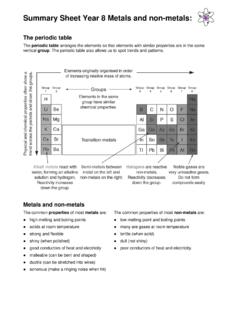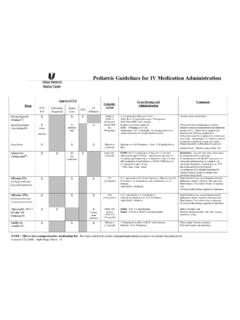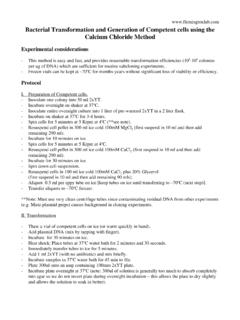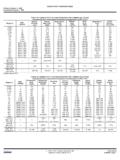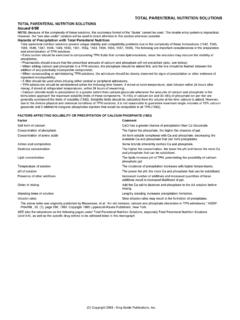Transcription of Material Safety Data Sheet - Calcium Chloride
1 Material Safety Data Sheet The Dow Chemical Company Product Name: PELADOW* Premier Snow and Ice Melter Calcium Issue Date: 01/12/2007. Chloride (50 lb Bag). Print Date: 17 Jan 2007. The Dow Chemical Company encourages and expects you to read and understand the entire (M)SDS, as there is important information throughout the document. We expect you to follow the precautions identified in this document unless your use conditions would necessitate other appropriate methods or actions. 1. Product and Company Identification Product Name PELADOW* Premier Snow and Ice Melter Calcium Chloride (50 lb Bag). COMPANY IDENTIFICATION. The Dow Chemical Company 2030 Willard H. Dow Center Midland, MI 48674.
2 USA. Customer Information Number: 800-258-2436. EMERGENCY TELEPHONE NUMBER. 24-Hour Emergency Contact: 989-636-4400. Local Emergency Contact: 989-636-4400. 2. Hazards Identification Emergency Overview Color: White Physical State: Pellets Odor: Odorless Hazards of product: WARNING! Causes eye irritation. May cause skin irritation. May be harmful if swallowed. OSHA Hazard Communication Standard This product is a "Hazardous Chemical" as defined by the OSHA Hazard Communication Standard, 29. CFR Potential Health Effects Eye Contact: For dust: May cause severe eye irritation. May cause corneal injury. Effects may be slow to heal. Skin Contact: Brief contact is essentially nonirritating to skin.
3 Prolonged contact may cause skin irritation, even a burn. Not classified as corrosive to the skin according to DOT guidelines. May cause * Indicates a Trademark Page 1 of 8. Product Name: PELADOW* Premier Snow and Ice Melter Calcium Issue Date: 01/12/2007. Chloride (50 lb Bag). more severe response if skin is damp. May cause more severe response if skin is abraded (scratched or cut). May cause more severe response on covered skin (under clothing, gloves). Skin Absorption: Prolonged skin contact is unlikely to result in absorption of harmful amounts. Inhalation: Dust may cause irritation to upper respiratory tract (nose and throat). Vapors are unlikely due to physical properties.
4 Ingestion: Low toxicity if swallowed. Small amounts swallowed incidentally as a result of normal handling operations are not likely to cause injury; however, swallowing larger amounts may cause injury. Swallowing may result in gastrointestinal irritation or ulceration. Effects of Repeated Exposure: The data presented are for the following Material : Potassium Chloride . In animals, effects have been reported on the following organs after ingestion: Gastrointestinal tract. Heart. Kidney. Dose levels producing these effects were many times higher than any dose levels expected from exposure due to use. 3. Composition Information Component CAS # Amount Calcium Chloride 10043-52-4 > - < %.
5 Water 7732-18-5 > - < %. Potassium Chloride 7447-40-7 > - < %. Sodium Chloride 7647-14-5 > - < %. 4. First-aid measures Eye Contact: Immediately flush eyes with water; remove contact lenses, if present, after the first 5. minutes, then continue flushing eyes for at least 15 minutes. Obtain medical attention without delay, preferably from an ophthalmologist. Skin Contact: Wash skin with plenty of water. Inhalation: Move person to fresh air; if effects occur, consult a physician. Ingestion: Do not induce vomiting. Give one cup (8 ounces or 240 ml) of water or milk if available and transport to a medical facility. Do not give anything by mouth to an unconscious person. Notes to Physician: Due to irritant properties, swallowing may result in burns/ulceration of mouth, stomach and lower gastrointestinal tract with subsequent stricture.
6 Aspiration of vomitus may cause lung injury. Suggest endotracheal/esophageal control if lavage is done. If burn is present, treat as any thermal burn, after decontamination. No specific antidote. Treatment of exposure should be directed at the control of symptoms and the clinical condition of the patient. 5. Fire Fighting Measures Extinguishing Media: This Material does not burn. If exposed to fire from another source, use suitable extinguishing agent for that fire. Fire Fighting Procedures: Keep people away. Isolate fire and deny unnecessary entry. This Material does not burn. Fight fire for other Material that is burning. Water should be applied in large quantities as fine spray.
7 Special Protective Equipment for Firefighters: Wear positive-pressure self-contained breathing apparatus (SCBA) and protective fire fighting clothing (includes fire fighting helmet, coat, trousers, boots, and gloves). Avoid contact with this Material during fire fighting operations. If contact is likely, change to full chemical resistant fire fighting clothing with self-contained breathing apparatus. If this is not available, wear full chemical resistant clothing with self-contained breathing apparatus and fight fire from a remote location. For protective equipment in post-fire or non-fire clean-up situations, refer to the relevant sections. Unusual Fire and Explosion Hazards: Heat is generated when product mixes with water.
8 Hazardous Combustion Products: Not applicable. Page 2 of 8. Product Name: PELADOW* Premier Snow and Ice Melter Calcium Issue Date: 01/12/2007. Chloride (50 lb Bag). 6. Accidental Release Measures Steps to be Taken if Material is Released or Spilled: Small and large spills: Contain spilled Material if possible. Collect in suitable and properly labeled containers. Flush residue with plenty of water. See Section 13, Disposal Considerations, for additional information. Personal Precautions: Isolate area. Keep unnecessary and unprotected personnel from entering the area. Use appropriate Safety equipment. For additional information, refer to Section 8, Exposure Controls and Personal Protection.
9 Refer to Section 7, Handling, for additional precautionary measures. Environmental Precautions: Prevent from entering into soil, ditches, sewers, waterways and/or groundwater. See Section 12, Ecological Information. 7. Handling and Storage Handling General Handling: Heat developed during diluting or dissolving is very high. Use cool water when diluting or dissolving (temperature less than 80 F, 27 C). Avoid contact with eyes, skin, and clothing. Do not swallow. Wash thoroughly after handling. Keep container tightly closed. See Section 8, EXPOSURE CONTROLS AND PERSONAL PROTECTION. Storage Store in a dry place. Protect from atmospheric moisture. 8. Exposure Controls / Personal Protection Exposure Limits Component List Type Value |||.
10 Calcium Chloride Dow IHG TWA 10 mg/m3. Personal Protection Eye/Face Protection: Use Safety glasses. For dusty operations or when handling solutions of the Material , wear chemical goggles. Skin Protection: Wear clean, body-covering clothing. Hand protection: Use gloves chemically resistant to this Material . If hands are cut or scratched, use gloves chemically resistant to this Material even for brief exposures. Examples of preferred glove barrier materials include: Neoprene. Polyvinyl Chloride ("PVC" or "vinyl"). Nitrile/butadiene rubber ("nitrile" or "NBR"). NOTICE: The selection of a specific glove for a particular application and duration of use in a workplace should also take into account all relevant workplace factors such as, but not limited to: Other chemicals which may be handled, physical requirements (cut/puncture protection, dexterity, thermal protection), potential body reactions to glove materials, as well as the instructions/specifications provided by the glove supplier.
